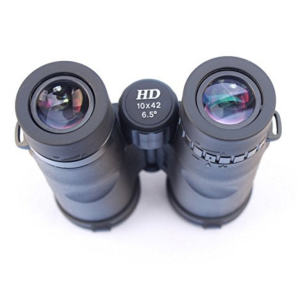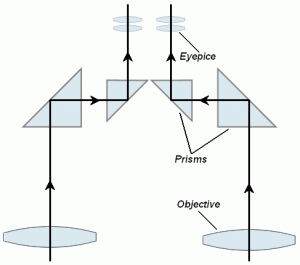 Binoculars, field glasses, telescopes. We see them in action adventure films, high seas capers and spy thrillers. The first telescopic lens was attributed to the research of Hans Lippershey (1608), who marketed his device in Holland. Much of the fanfare surrounding 17th century optics focused on the inventions of Galileo — Galilean optics.
Binoculars, field glasses, telescopes. We see them in action adventure films, high seas capers and spy thrillers. The first telescopic lens was attributed to the research of Hans Lippershey (1608), who marketed his device in Holland. Much of the fanfare surrounding 17th century optics focused on the inventions of Galileo — Galilean optics.
Exactly.
Galilean optics refers to the telescope designed by, of course, Galileo in 1609. Comprised of a plano-convex lens and a plano-concave lens at the eyepiece, this technology was able to magnify viewed objects by 30x. Not bad. It allowed Galileo to see the moon’s craters. And if that isn’t exciting — modern day improvements on Galileo’s creation allow you to see that yellow warbler in the apple tree at a hundred feet away. That’s just as intriguing as looking at dust pits on the moon.
Sir Isaac Newton of the “falling apple gravity” fame, reconsidered earlier designs and came up with a novel approach involving the use of mirrors. The mirror lens collected the light and used reflection to gather that light to a focal point. The power of the mirror’s ability to do this allowed for magnification possibilities far beyond those of standard lens capabilities. Telescopes moved from double-digit magnifications to those in the millions.
The modern binocular, which consists of two “telescopes,” didn’t appear (pun intended) until the early 19th century. An Italian inventor, Ignatio Porro, saw the light and used prisms to concoct his binocular in 1854. Curiously, Lippershey was originally told to fashion his single-style field glass into a double – binocular – design in 1608! Everything old is new again. Unfortunately, none of these inventors had bird watching in mind. Now that really is astounding.
What do binoculars do best? Magnify birds!
 Having a hardscrabble pair of quality binoculars is as important as a good field guide for birdwatching. The problem is, many birders focus on their “homework,” identifying birds, learning calls and habitat (all important) but don’t spend any time researching binoculars. Bird watchers want birds, not technology. No one wants to waste time with a bunch of optics lectures when there are avians waiting outdoors. Besides, you don’t want to require a degree from MIT to figure out binoculars, just pack any old pair that’s easy to use. That approach is not a good idea. Here is why.
Having a hardscrabble pair of quality binoculars is as important as a good field guide for birdwatching. The problem is, many birders focus on their “homework,” identifying birds, learning calls and habitat (all important) but don’t spend any time researching binoculars. Bird watchers want birds, not technology. No one wants to waste time with a bunch of optics lectures when there are avians waiting outdoors. Besides, you don’t want to require a degree from MIT to figure out binoculars, just pack any old pair that’s easy to use. That approach is not a good idea. Here is why.
You need to purchase a pair of binoculars that:
- Don’t require a Ph.D. to understand.
- Are easy to use.
If you run out and buy the cheapest and smallest pair for sale at your local dime store – you will be disappointed. They won’t do the one thing we birders absolutely require in a pair of binoculars.
Birdwatching binoculars need to be able to focus QUICKLY! Ah, most of us have been there. We grab grandpa’s clunky double-telescopes, rip off the covers and run to the window to get a close look at the pileated woodpecker drumming on the old maple.
You’re flipping aside that darn neck strap and turning the stupid focus grips. This is a horse race, darn it, you don’t have all day. Come on…come on, focus you %^^&&. The pileated woodpecker got sick of those binoculars too…and flew into the forest. Yup.
What you WANT:
- Light-weight binoculars that will fit in your gear and not require you to weight lift in order to use them in the field. If you have ever focused a pair of heavy lenses for long-term species’ observation, your arms feel like you are a losing contestant on a reality show. “How long can you hold your arms up? BEEEP, time’s up.”
- The binoculars must be designed well enough to register brightness/light in many field conditions, including low light.
- The binoculars need excellent acuity. They must be able to focus on a distant bird and provide you with exquisite clarity. You need to be able to distinguish feather patterns, plumage color (produced through a lens’ prism coatings) and fine details.
- Focus, focus, focus. Unlike the birder using grandpa’s spyglass, you want a pair that will focus quickly and sharply. If you ever tried “following” a bird as he winged his way by, you know how important this is. It is very easy to “lose” sight and track of a moving bird.
- Magnification is a variable. For most enthusiasts choose a pair that will deliver 7 or 8x. The higher the magnifying abilities the heavier the binoculars. For birders that will be doing
 frequent and dedicated distance sightings, invest in a tripod set-up.
frequent and dedicated distance sightings, invest in a tripod set-up. - Distance and power is not always an advantage. Backyard and homestead birdwatchers that want to get “up close” to the visitors at feeding stations will want to consider binoculars that offer a close-focus feature.
For specific information on how binoculars work click here – Optics Den.
Note: People who use spectacles know the trials of propping binoculars in front of their eyeglasses. Your glasses make the experience frustrating. The image is hard to get into focus and you may only get a clear view of the center, and even then, you are squinting and everything is wavering. This is because binoculars are designed by how far your eye is from the piece! Your glasses change this distance. Purchase binoculars with “eye relief” features – 16mm (for low prescriptions only) —20mm. Or, wear contacts when you go birdwatching!
Porro Prism and Roof Prism
Porro prism binoculars are the old-standard. Just like your father’s Buick, these hinged field glasses with the off-kilter lens path still do the job. And if you require a low-priced pair for simple and occasional backyard viewing purposes — these will certainly give you contrast and clarity. They are worth their weight, and price, for hobby birders.
Roof prism binoculars replaced the porro over 40 years ago. These sleek, modern “flat-bridge” designed glasses allow for a straight line from the eyepiece to the objective lenses. Requiring more precise manufacturing techniques their price reflects that. Most binoculars are roof prism, but be sure to buy a quality pair (and the $$ will reflect that).
If you have simple needs and/or a low budget – purchase the porro models.
Your purchase
Binoculars are like cars. You can buy a Toyota or you can buy a Porsche. It’s up to you and your budget. Visit a local birding store or sporting store to talk to the experts about your needs. Always mention that you will be using the binoculars for birdwatching and also whether you will require a pair for backyard spotting or serious field observations. There are so many variables beyond price, that only an expert can assist you in getting the perfect pair of binoculars that will last “forever.” Try out the field glasses to find the design and model that you feel the most comfortable using.
For more information on which binoculars will work for your needs visit the Optics Den. A specialist is waiting to assist you.
What are your favorite binoculars? Leave us a comment and let us know what birdwatchers are using today!
